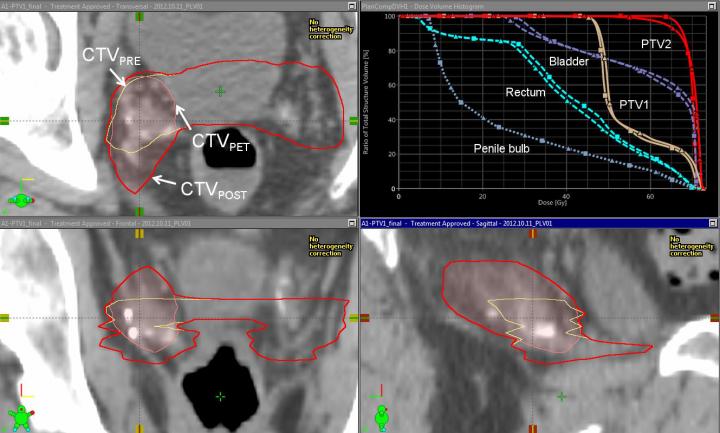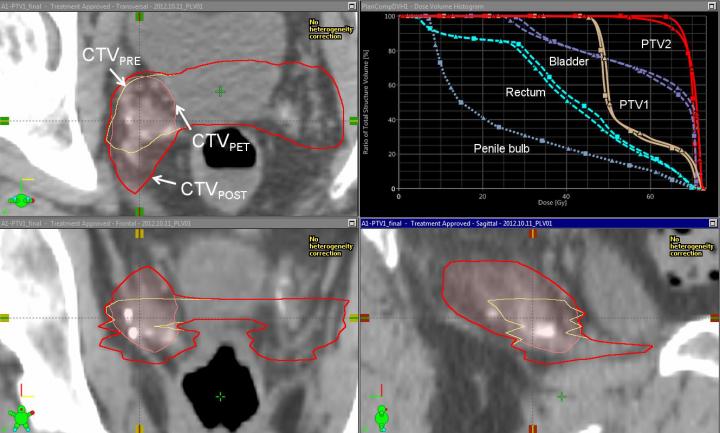
Credit: Ashesh B. Jani, MD, and David Schuster, MD, Emory University.
Reston, Va. (March 6, 2017) – The featured clinical investigation article of the March 2017 issue of the Journal of Nuclear Medicine demonstrates that the PET radiotracer fluciclovine (fluorine-18; F-18) can help guide and monitor targeted treatment for recurrent prostate cancer, allowing for individualized, targeted therapy.
"This is the first study of its kind demonstrating changes in post-surgery radiotherapy target design with advanced molecular imaging in recurrent prostate cancer, with no demonstrated increase in early radiotherapy side effects," explains Ashesh B. Jani, MD, of the Winship Cancer Institute of Emory University, Atlanta, Georgia.
According to the American Cancer Society, one in seven men will develop prostate cancer in his lifetime. In 2017, more than 161,000 new cases of prostate cancer are expected to be diagnosed in the U.S., and about 26,730 deaths from the disease are anticipated.
For the study, 96 patients were enrolled in a clinical trial of radiotherapy for recurrent prostate cancer after prostatectomy. All patients underwent initial treatment planning based on results from conventional abdominopelvic imaging (CT or MRI). Forty-five of the patients then underwent treatment-planning modification (better defining the tumor-targeted area) after additionally undergoing abdominopelvic F-18-fluciclovine PET/CT. No increase in toxicity was observed with this process.
The Emory researchers determined that the inclusion of F-18-fluciclovine PET information in the treatment planning process leads to significant differences in target volumes (the areas to receive radiotherapy). It did result in higher radiation dose delivered to the penile bulb, but no significant differences in bladder or rectal radiation dose or in acute genitourinary or gastrointestinal toxicity.
These are preliminary results in a three-year study, which hypothesizes that there will be an increase in disease-free survival for patients in the F-18-fluciclovine-modified treatment group over those in the standard treatment group.
This study could have implications beyond prostate cancer, Jani points out, "Our methodology is readily applicable to other novel imaging agents, and it may potentially facilitate improvement of cancer control outcomes."
###
Authors of the article "Impact of Fluciclovine (18F) PET on Target Volume Definition for Post-Prostatectomy Salvage Radiotherapy: Initial Findings from a Randomized Trial" include Ashesh B. Jani, Eduard Schreibmann, Peter J. Rossi, Joseph Shelton, Karen Godette, Peter Nieh, Viraj A. Master, Omer Kucuk, Mark Goodman, Raghuveer Halkar, Sherrie Cooper, Zhengjia Chen, and David M. Schuster, Emory University, Atlanta, Georgia.
This research was sponsored by the National Institutes of Health (R01 CA169188) and Blue Earth Diagnostics Ltd.
Please visit the SNMMI Media Center to view the PDF of the study, including images, and more information about molecular imaging and personalized medicine. To schedule an interview with the researchers, please contact Laurie Callahan at (703) 652-6773 or [email protected]. Current and past issues of the Journal of Nuclear Medicine can be found online at http://jnm.snmjournals.org.
About the Society of Nuclear Medicine and Molecular Imaging
The Society of Nuclear Medicine and Molecular Imaging (SNMMI) is an international scientific and medical organization dedicated to raising public awareness about nuclear medicine and molecular imaging, a vital element of today's medical practice that adds an additional dimension to diagnosis, changing the way common and devastating diseases are understood and treated and helping provide patients with the best health care possible.
SNMMI's more than 17,000 members set the standard for molecular imaging and nuclear medicine practice by creating guidelines, sharing information through journals and meetings and leading advocacy on key issues that affect molecular imaging and therapy research and practice. For more information, visit http://www.snmmi.org.
Media Contact
Laurie Callahan
[email protected]
@SNM_MI
http://www.snm.org
############
Story Source: Materials provided by Scienmag




